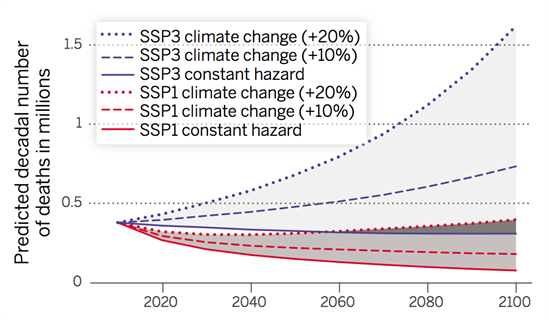
Education is “top priority” for climate change adaptation, study shows
Robert McSweeney
11.27.14Robert McSweeney
27.11.2014 | 7:00pmEducation does more to reduce deaths from climate-related disasters than economic growth, a new study finds. The researchers say education helps reduce vulnerability to disasters and enhances adaptation to climate change.
Financing adaptation
It’s hard to pin down exactly how much money developing countries need to adapt to climate change. But some estimates suggest that it could be as much as $100 billion a year.
Countries have so far pledged $9 billion to the UN Green Climate Fund, which will provide money for adaptation and mitigation in developing countries.
Spending on climate change adaptation tends to be focused on large infrastructure projects, such as flood defences and irrigation systems. But new research, published in Science, suggests that investing in education could be a better way to reduce vulnerability to climate-related disasters.
Improving education reduces disaster deaths
The researchers argue that previous studies have concentrated too heavily on how economic development has reduced vulnerability to disasters such as floods, droughts and landslides.
They point to recent case studies that show improvements in education can give people the skills and knowledge to be better prepared for, and better able to recover from, natural hazards. For example, better-educated people in Cuba, Haiti and the Dominican Republic were faster at responding to hurricane alerts and recuperated more quickly once one had struck.
The researchers compare the influence economic growth and education have on the number of deaths from disasters for 167 countries across the world. They use Gross Domestic Product (GDP) per person as an indicator of economic growth and the number of women completing at least secondary school education as an indicator for education. They then cross-reference these with a database of climate-related disasters.
The results suggest that rising GDP has not reduced the number of deaths from climate-related disasters in the past four decades, while having a greater number of women in education has.
Better awareness of risk
So how does education reduce vulnerability to climate-related disasters? In an accompanying press release, co-author Dr Raya Muttarak explains:
“Education directly improves knowledge, the ability to understand and process information, and risk perception. It also indirectly enhances socioeconomic status and social capital. These are qualities and skills useful for surviving and coping with disasters.”
Educated people have a better awareness of risk, the authors argue, and it gives them the knowledge and skills to adapt flexibly.
This is important because while scientists can make long-term projections of climate change, year-to-year weather variations mean they can’t say exactly when a disaster will hit and how severe it will be. So a flexible approach to adaptation gives people and communities more capacity to cope when a disaster occurs.
Projecting future disaster deaths
When the researchers run simulations of future climate-related disasters, they find a similar pattern: improved education significantly reduces the number of deaths from disasters.
The results are shown in the graph below. The researchers use two pathways of how global education might change in the future: rapid expansion (red lines) and limited expansion (blue lines), which indicate, respectively, either substantial or minimal investment in education around the world.
The study models each education pathway against three scenarios of future change in climate-related disasters: no change (solid line), a 10 per cent increase (dashed line) and a 20 per cent increase (dotted line).
You can see that for each scenario of climate-related disasters, the improved education pathway results in fewer deaths.
The results suggest how “education is key in reducing disaster fatalities and enhancing adaptive capacity,” says lead author Professor Wolfgang Lutz in the press release.
Predicted number of disaster deaths (in millions) per decade with rapid expansion of education (SSP1) and limited expansion (SSP3). The graph shows three scenarios of changing extreme events: no change (solid line), a 10 per cent increase (dashed line) and a 20 per cent increase (dotted line).
Adaptation through education
Investment in education should be “top priority” for adapting to climate change in developing countries, the authors recommend. Though as people tend to be educated during their early years, the benefits of improving or expanding an education system may not be seen for several decades.
These findings add to the recent report from the Royal Society that suggests large-scale engineering projects are not the only way to adapt to climate change. It recommends a balanced approach to adaptation of both engineering and ecosystem-based measures.
Main image: Pupils raising a hand during a geography lesson. Credit: wavebreakmedia/Shutterstock.com.
Lutz, W. et al. (2014) Universal education in key to enhanced climate adaptation, Science, doi/10.1126/science.1257975


